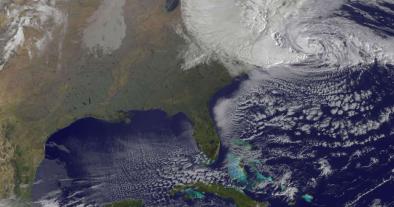Science Source
Hurricane Sandy before 1900 and after 2100
- Investigates the following questions:
- To what extent did large-scale thermodynamic climate change contribute to the intensity and unusual track of Hurricane Sandy, which affected the U.S. mid-Atlantic region in late October 2012?
- How much of an impact would projected future climate change have on a storm such as Sandy?
- Uses an ensemble of high-resolution numerical simulations in conjunction with analyzed and projected changes from a suite of general circulation models (GCMs)
- Confirms that simulations initialized with current analyses from the midpoint of Sandy’s life cycle, while the system was centered near the Bahamas, adequately replicate the observed intensity and track of Sandy
- Alters initial and boundary conditions with thermodynamic change fields obtained from a five-member GCM ensemble, allowing hypothetical replication of the synoptic weather pattern that accompanied Hurricane Sandy, but for large-scale thermodynamic conditions corresponding to the 1880s and for projections to the twenty-second century
- Finds that the past ensemble produces a slightly weaker storm that makes landfall south of the observed location
- Finds that the future ensemble depicts a significantly more intense system that makes landfall farther north, near Long Island, New York
- Concludes by stating that the strengthening in the simulations run with projected future warming is consistent with increased condensational heating; changes in the synoptic steering flow also appear to result from diabatic processes
- Notes that the questions of how climate change affected Sandy’s genesis and early life cycle, changes in the frequency of this type of synoptic pattern, and changes in impacts related to coastal development and sea level rise are not considered here
Related Content
Headline

Oct 30, 2017 | Mother Jones
Here's what we've learned about hurricanes since Sandy
Science Source
| Lloyds
Catastrophe Modelling and Climate Change
Ralf Toumi and Lauren Restell
Headline

Aug 30, 2017 | NY Daily News
NYCHA paints over Brooklyn housing project's toxic mold issue
Headline

Jun 27, 2017 | US News & World Report via Associated Press
NYC Subway Station Reopens After Superstorm Sandy Flooding


